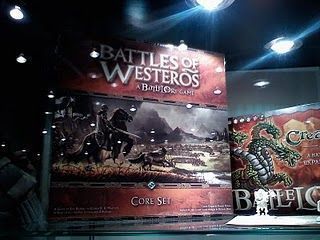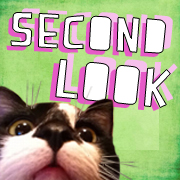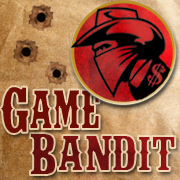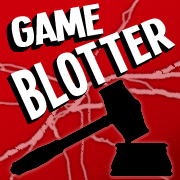Welcome to Purple Pawn, covering games played around the world by billions of people every day.
 Fantasy Flight Games has announced the last of their three winter game announcements: Battles of Westeros. This two player wargame is based on the immensely popular Song of Fire and Ice universe from George R. R. Martin (who’s setting is no stranger to FFG games). Rather than use a new rules set, BoW uses the beloved Battlelore rules. This strikes me as an interesting decision that makes the game immediately accessible thanks to the widely used Commands & Colors system, but may disppoint Battlelore fans who were hoping for a new big box expansion rather than a brand new game. Battles of Westeroa is set to release this November and Martin himself will be on hand at FFG’s new event center to play the game with fans at launch.
Fantasy Flight Games has announced the last of their three winter game announcements: Battles of Westeros. This two player wargame is based on the immensely popular Song of Fire and Ice universe from George R. R. Martin (who’s setting is no stranger to FFG games). Rather than use a new rules set, BoW uses the beloved Battlelore rules. This strikes me as an interesting decision that makes the game immediately accessible thanks to the widely used Commands & Colors system, but may disppoint Battlelore fans who were hoping for a new big box expansion rather than a brand new game. Battles of Westeroa is set to release this November and Martin himself will be on hand at FFG’s new event center to play the game with fans at launch.
[Major Hat Tip to The Hopeless Gamer]
Edited: Corrected source name.
Update: FFG has posted their official press release.
11 Comments
Sorry, the comment form is closed at this time.
Trending
- Massdrop.com
- Oh the Irony—Illuminati Card Game Continues to Inspire Conspiracy Theorists
- Home
- Footprints, an Educational Ecology Game
- USPS Adds Board Game Flat Rate Box
- Baila, the Estonian Drinking Card Game
- Crystal Caste Wins Dice Patent Suit Against Hasbro
- Mirror Game, Red and Blue
- Are Board Games Dangerous?
- The Truth About Dominoes On Sunday in Alabama
Archives
Most Popular Articles
- Oh the Irony—Illuminati Card Game Continues to Inspire Conspiracy Theorists
- The 20 Most Valuable Vintage Board Games
- The Truth About Dominoes On Sunday in Alabama
- Sequence Game, and Variants
- USPS Adds Board Game Flat Rate Box
- Baila, the Estonian Drinking Card Game
- The 13 Most Popular Dice Games
- Are Board Games Dangerous?
- Guess Who? The Naked Version
- What Happened to the Jewel Royale Chess Set?
Recent Posts
- Toy Fair 2019—Breaking Games
- Talisman Kingdom Hearts Edition
- Toy Fair 2019—Winning Moves
- Toy Fair 2019—Games Workshop
- Toy Fair 2019—Star Wars Lightsaber Academy
- Toy Fair 2019—Stranger Things Games
- Toy Fair 2019—HABA
- Licensing Roundup
- Game Bandit
- 2018 A Difficult Year For Hasbro But Not For D&D Or MtG
Recent Comments
- on Toy Fair 2019—Winning Moves
- on Game Bandit
- on Second Look—Dungeons & Dragons Waterdeep Dragon Heist
- on Crowdfunding Highlights
- on Beyblade SlingShock
- on Game Bandit
- on Game Bandit
- on Watch This Game!, the Board Game Review Board Game
- on Second Look—Vampire: The Masquerade 5th Edition
- on Palladium Books Loses Robotech IP License, Cancels Five-Year-Overdue Robotech RPG Tactics Kickstarter





Appreciate the hat tip, but for reference, its “The Hopeless Gamer” not “The Lonley Gamer” Thanks!
And therein lies the danger of blogging from the iPhone – the WordPress app is a bit quirky on edits ;) Corrected – thanks for posting!
No problem, thanks for the fix!
“Rather than use a new rules set, BoW uses the beloved Battlelore rules. ”
I got a chance to play this on Saturday and I would say that line is a little misleading. It has the command and color system as a base, but it is a completly different beast.
When I got the chance to play, I thought this is cool, I know how to play Battlelore, but it will be cool to play it with the Westeros theme. I was playing a completly different game and I liked it.
How would you say the games are different? Obviously it’s a different card mix and the magic is different (thank goodness), but the game is even subtitled “A Battlelore Game” (which has caused quite the stir on the geek!).
I own and have played quite a bit of Battlelore, Memoir and Battle Cry. Battle of Westeros is actually quite a different beast and I enjoyed it. We only played the introductory scenario, so we didn’t get to try all the new mechanics out, but after the game he showed us a bunch of the other things that were coming with the core set. Be forewarned that I am probably not remembering all the exact rulebook terminology for everything, so I may call things different names than they will actually be and I believe things are probably still subject to change.
The core set will pit Starks against the Lannisters and comes with 138 figures and lots of cards, plus the terrain tiles and dice and various other punch card tokens. We were playing with a beta copy that didn’t have the final components. But the final components we did have were typical FFG quality.
One of the first very noticeable differences is the 8 sided dice rather than the familiar six. This I believe is a great change and makes a lot more sense. If I remember correctly green units have 3 sides of the die, while blue has 2 and red has one. The other two sides have a rally and a wild symbol.
The boards will not have anything on the edges so they can be placed adjacent to each other for larger games.
Also, the victory point track is gone. Now games will be won with specific objectives or a rout. In our scenario the Starks started with two objective hexes under their control that I as the Lannister player needed to control at the end of the fifth turn. The other way to try and win would be a rout. In order to rout your opponent, there is a morale track off to the side that swings back and forth typically when you lose a unit you lose favor equal to its rank. A green unit swings it one space, with blue moving it two and a red moving it three spaces. There is also a way to force march your troops and you can lose morale that way as well. There are also colored ares of the track that you can reset your morale to at the end of each round, so your opponent needs to really kill a lot in one round in order to knock you back to the next level.
Another huge difference is no left, right or center zones and no shared order cards. Instead each player has their own basic deck that has the same cards in it and then gets to add to it more cards depending on the leaders they choose for their army. There will also be different versions of the leaders to represent them at different times with different cards. These leaders also have reference cards and are an actual figure on the board within one of your units that provide special abilities in the game. One is a multi-use ability and the other is a once per game ability.
At the beginning of your turn you can draw three cards from your deck and roll four dice. You will then take a token matching each color die you roll each turn. Then on the round you will issue orders in one of two ways. You can play one of your tokens to order one of the matching colored units on the board anywhere or you can play a card. Each of these cards has a cost of generally one command point which you move onto the reference card of the leader you want to use. That leader can command any of the untis within 2 hexes of it’s space including it’s own unit. The first player to take a turn each round is determined by who spends less of these command tokens, so there is some strategy there as well. The players will take turns ordering units back and forth until both players pass, once a player has passed they will not be able to play again until the next round. Also, each unit must rotate it’s banner after it has been ordered to signify that that unit can not act again until next round. There are some cards thatn can rally these units which allows them to act again, also if any of a player’s rolled dice at the beginning of the turn earned them a rally token they can use it to force march any unit on the board which decreases the players morale one spot and rotate the unit’s banner back to active, also this rally token can be used to move a players morale back up one space. At the end of the turn players have to discard down to one card and one token.
The terrain overall is pretty similar as well as the dice and movement of the figures based on their colors. One difference is that pursuit is only able to be done once.
Battles of Westeros also add flanking and disengagement. When a unit attacks another unit from an adjacent hex, the player places one of their engagement tokens in betweent the units. Then if another unit attacks from another adjacent hex they get flanking this allows them to reroll any dice of the same face. Also, if either of the engaged units wants to move away or attack a different adjacent enemy, they will suffer an attack from the unit they are engaged with before they make their attack.
I am probably forgetting things and I am sure some of my rambling is unclear, so ask questions and I will try to get more information out of my brain and clarify things.
Outstanding! Thanks for the additional info!
Wow! This does sound different then the Commands & Colors system. And while I still love C&C, this sounds like a lot of fun.
Thank you, Michael.
For some analysis of the business implications of this BattleLore game, I highly recommend reading:
http://pawnderings.blogspot.com/2010/02/ffg-interview-has-serious-implications.html
Apparently, BattleLore has become a brand name because the original base set is too expensive to manufacture.
What about the figures – how big are they and what level of detail? Also, how many various types of fighting units are there?
The figures are the same size as the Battlelore figures and of similar detail. Maybe slightly more detailed?